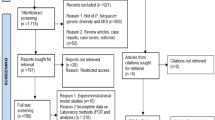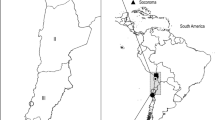Abstract
Anopheles culicifacies, the principal vector of malaria in India, is a complex of five cryptic species which are morphologically indistinguishable at any stage of life. In view of the practical difficulties associated with classical cytotaxonomic method for the identification of members of the complex, an allele-specific polymerase chain reaction (ASPCR) assay targeted to the D3 domain of 28S ribosomal DNA was developed. The assay discriminatesAn. culicifacies species A and D from species B, C and E. The assay was validated using chromosomally-identified specimens ofAn. culicifacies from different geographical regions of India representing different sympatric associations. The assay correctly differentiates species A and D from species B, C and E. The possible use of this diagnostic assay in disease vector control programmes is discussed.
Similar content being viewed by others
References
Adak T, Subbarao S K, Sharma V P and Rao S R V 1994 Lactate dehydrogenase allozyme differentiation of species in theAnopheles culicifacies complex;Med. Vet. Entomol. 8 137–140
Adak T, Kaur S and Singh O P 1999 Comparative susceptibility of different members of theAnopheles culicifacies complex toPlasmodium vivax;Trans. R. Soc. Trop. Med. Hyg. 93 573–577
Coen E S, Strachan T and Dover G 1982 Dynamics of concerted evolution of ribosomal DNA and histone gene families in the melanogaster species subgroup ofDrosophila;J. Mol. Biol. 158 17–35
Collins F H and Paskewitz S M 1996 A review of the use of ribosomal DNA (rDNA) to differentiate among crypticAnopheles species;Insect Mol. Biol. 5 1–9
Green C A and Hunt R H 1980 Interpretation of variation in ovarian polytene chromosomes ofAnopheles funestus Giles,A. parensis Giles and A.aruni?;Genetica 51 187–195
Green C A and Miles S J 1980 Chromosomal evidence for sibling species of the malaria vectorAnopheles (Cellia) culicifacies Giles;J. Trop. Med. Hyg. 83 75–78
Gunasekera M B, de Silva B G D N K, Abeyewickreme W, Subbarao S K, Nandadasa H G and Karunayayake E H 1995 Development of DNA probes for the identification of sibling species A of theAnopheles culicifacies (Diptera: Culicidae) complex;Bull. Entomol. Res. 85 345–353
Kar I, Subbarao S K, Eapen A, Ravindran J, Satyanarayana T S, Raghavendra K, Nanda N and Sharma V P 1999 Evidence for a new malaria vector species, species E, within theAnopheles culicifacies complex (Diptera: Culicidae);J. Med. Entomol. 36 595–600
Kaur S, Singh O P and Adak T 2000 Susceptibility of species A, B and C ofAnopheles culicifacies complex toPlasmodium yoelii yoelii andPlasmodium vinckei petteri infections;J. Parasitol. 86 1345–1348
Krzywinski J and Besansky N J 2003 Molecular systematics ofAnopheles: from subgenera to subpopulations;Annu. Rev. Entomol. 48 111–139
Litvaitis M K, Nunn G, Thomas W K and Kocher T D 1994 A molecular approach for the identification ofMeiofaunal turbellarians (Platyhelminthes, Turbellaria);Marine Biol. 120 437–442
Mulligan P J M, Phillips A, Molyneux D H, Subbarao S K and White G B 1986 Differentiation ofAnopheles culicifacies Giles (Diptera: Culicidae) sibling species by analysis of cuticular components;Bull. Entomol. Res. 76 529–527
Raghavendra K, Vasantha K, Subbarao S K, Pillai M K K and Sharma V P 1991 Resistance inAnopheles culicifacies sibling species B and C to malathion in Andhra Pradesh and Gujarat States, India;J. Am. Mosq. Control Assoc. 7 255–259
Raghavendra K, Subbarao S K, Vasantha K, Pillai M K K and Sharma V P 1992 Differential selection of malathion resistance inAnopheles culicifacies A and B (Diptera: Culicidae) in Haryana State, India;J. Med. Entomol. 29 183–187
Sharma V P 1998 Fighting malaria in India;Curr. Sci. 75 1127–1140
Sharpe R G, Hims M M, Harbach R E and Butlin R K 1999 PCR-based methods for the identification of species of theAnopheles minimus group: allele specific amplification and single strand conformation polymorphism;Med. Vet. Entomol. 13 265–273
Singh O P, Chandra D, Nanda N, Raghavendra K, Sunil S, Sharma S K, Dua V K and Subbarao S K 2004 Differentiation of members of theAnopheles fluviatilis species complex by an allele-specific polymerase chain reaction based on 28S ribosomal DNA sequences;Am. J. Trop. Med. Hyg. 70 27–32
Subbarao S K 1998Anopheles species complexes in South East Asia region (Technical publication No. 18) (New Delhi: World Health Organization, South East Asia Regional Office)
Subbarao S K, Vasantha K, Adak T and Sharma V P 1983Anopheles culicifacies complex: evidence for a new sibling species, species C;Ann. Entomol. Soc. Am. 76 985–988
Subbarao S K, Vasantha K, Raghavendra K, Sharma V P and Sharma G K 1988aAnopheles culicifacies: sibling species composition and its relationship to malaria incidence;J. Am. Mosq. Control Assoc. 4 29–33
Subbarao S K, Vasantha K and Sharma V P 1988b Responses ofAnopheles culicifacies sibling species A and B to DDT and HCH in India: implications in malaria control;Med. Vet. Entomol. 2 219–223
Subbarao S K, Vasantha K, Joshi H, Raghavendra K, Usha Devi C, Sathyanarayan T S, Cochrane A H, Nussenzweig R S and Sharma V P 1992 Role ofAnopheles culicifacies sibling species in malaria transmission in Madhya Pradesh state, India;Trans. R. Soc. Trop. Med. Hyg. 86 613–614
Vasantha K, Subbarao S K and Sharma V P 1991Anopheles culicifacies complex: population cytogenetic evidence for species D (Diptera: Culicidae);Ann. Entomol. Soc. Am. 84 531–536
Author information
Authors and Affiliations
Corresponding author
Rights and permissions
About this article
Cite this article
Singh, O.P., Goswami, G., Nanda, N. et al. An allele-specific polymerase chain reaction assay for the differentiation of members of theAnopheles culicifacies complex. J Biosci 29, 275–280 (2004). https://doi.org/10.1007/BF02702609
Received:
Accepted:
Issue Date:
DOI: https://doi.org/10.1007/BF02702609




